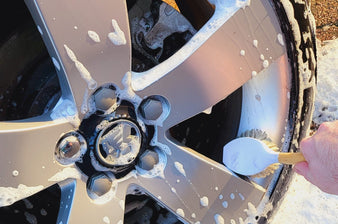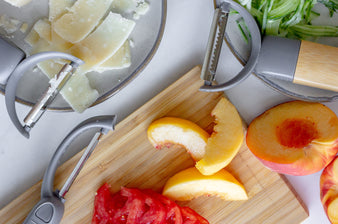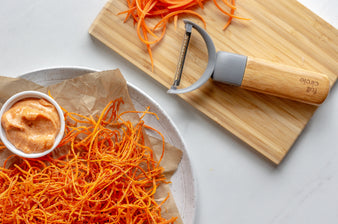The Ultimate Produce Keeper Guide
Produce can be finnicky – each item has its own properties and best ways to be stored. We’ve done months of research and trial and error to bring you what we think is the best, easiest way to store the most popular produce (using our bags, of course!):
Using our “Heads” bag:
- Cauliflower head: if purchased in a plastic wrapping, do not remove. Place the wrapped head of cauliflower stem down in our heads bag to allow circulation and prevent moisture from building up and causing the florets to brown. Do not wash until ready to use. Seal the bag most of the way, leaving a little part open to allow for small amounts of evaporation. Can be stored on shelf or in crisper drawer.
- If purchased not in plastic, follow the same directions above. The bag will protect the head the same way.
- If stored correctly, cauliflower heads should last up to 7-14 days in the fridge.
- Broccoli crown: if purchase in a plastic wrapping, remove. Do not wash until ready to use. Wrap the crown loosely in a damp Reusable Plant Towel (check out our Tough Sheets!), reusable towel, or paper towel. Place in our heads bag and do not seal all the way to allow for air circulation. Can be stored on shelf or in crisper drawer.
- If stored correctly, broccoli crowns should last up to 5 days in the fridge.
- Head of Romanesco (AKA Roman Cauliflower): Do not wash until ready to use. Place head of Romanesco directly in our heads bag, stem side down, and seal the bag all the way.
- To maximize flavor, Romanesco should be used 1-2 days after storage, but will last up to 5 days in the fridge if stored properly. Can be stored on shelf or in crisper drawer.
- Heads of Lettuce (Iceberg, Romaine, Butterhead (Bibb), Red Leaf): Leave the heads intact and do not wash until ready to use. Remove any damaged or wilted leaves. Wrap the head loosely in a dry Reusable Plant Towel (check out our Tough Sheets!), reusable towel, or paper towel. Place in our heads bag – do not seal all the way. Can be stored on shelf or in crisper drawer.
- All of these types of heads of lettuce should stay fresh and crisp for 7-10 days if stored properly.
- If any of these come wrapped in plastic (typically iceberg or romaine), keep them wrapped and place them in the bag. Do not seal all the way.
Using our “Stalks” bag:
- Swiss Chard and Collared Greens: Do not wash until ready to use and keep on stem. Wrap the stalk loosely in a damp Reusable Plant Towel (check out our Tough Sheets!) reusable towel, or paper towel. Put wrapped stalks in our stalks bag and do not seal. These should last up to 5 days in the fridge if stored properly. Can be stored on shelf or in crisper drawer.
- Celery Stalks: Do not wash until ready to use and keep intact. Wrap the stalk loosely in a dry Reusable Plant Towel (check out our Tough Sheets!), reusable towel, paper towel, or aluminum foil. Place in our stalks bag and do not seal. Can be stored on shelf or in crisper drawer. This should last up to 2 weeks in the fridge if stored properly.
- Carrots on Stalk or Loose: Do not peel or wash until ready to use. Remove the leafy green carrot tops (if the producer has not already removed them) – the leafy tops will remove much needed moisture from the carrots and cause them to go limp more quickly. Save these for veggie stock or compost them! Wrap the carrots loosely in a damp Reusable Plant Towel (check out our Tough Sheets!), reusable towel, or paper towel. Place in our stalks bag and do not seal. These should last up to a whole month!
- Alternatively, carrots are guaranteed to stay fresh if you store them in water. Put enough water in the stalks bag to cover the carrots you’re storing in there and seal the bag completely (don’t worry, the bags and leak-proof!). By doing this, you can keep fresh, crunchy carrots for a month as well. Due to the water, we recommend storing these on a shelf only.
- Herbs: Depending on the size of your herbs, the stalks bag or the citrus bag would be a great place to store them.
- Hard herbs (Rosemary, Thyme, Chives, Sage, Oregano): Wrap the individual herb bunches loosely in a damp Reusable Plant Towel (check out our Tough Sheets!), reusable towel, or paper towel. Place in our stalks bag and seal to keep oxygen out.
- Soft herbs (Parsley, Cilantro, Dill, Mint, Tarragon, Chervil, Basil): Soft herbs should be stored standing up in the fridge. The best way to do so is to put some cool water in a cup or jar, and stand up your herbs, making sure the bottom of the stems are submerged. Place a reusable ziptuck bag (the citrus bag works great, or our Travel Ziptuck), compostable zipper bag, or plastic zipper bag over the top and seal slightly to keep humidity inside. Soft herbs should stay fresh for up to 3 weeks (cilantro tends to be closer to 1-2 weeks, though).
- For basil, follow the above directions but store on the counter out of direct sunlight. The leaves are too delicate to withstand the low temperatures in the fridge.
- Kale: Funny enough, kale is one of the only kinds of stalk vegetables that can be washed and torn before being used and still stay fresh for a long time. This applies to all kinds of kale – Tuscan (Dino), Curly Kale, Red Kale, etc. Rip kale off the stem and place in a colander. Rinse under cold water and let sit to dry. Once mostly dry (not many visible water droplets left), place a dry Reusable Plant Towel (check out our Tough Sheets!), reusable towel, or paper towel in the bottom of the Stalks bag (any of the bags can be used, just dependent on how much kale you have). Put all of the torn, washed kale in the bag on top of the towel. Before closing, put one more dry towel on top of the kale. Seal the bag completely and store on the shelf in your fridge or in the crisper drawer (the kale is completely insulated so it doesn’t matter where it is placed).
- Stored this way, fresh kale can last up to 3 weeks. Plus, it makes prep much easier when ready to use!
Using our fruit bag:
- Citrus (oranges, lemons, limes, grapefruits, pomelos, etc.): Can be placed in our fruit bag but should not be sealed. Can be stored on shelf (if no room in crisper drawer), but will last longest in your crisper drawer with the bag open.
- Most citrus should stay fresh for up to a month if stored properly.
- Berries (blueberries, blackberries, strawberries, raspberries): To keep berries from getting moldy, wash them in a vinegar solution (3 cups water + 1 cup white vinegar) – this kills bacteria and mold spores! After washing, lay them out on a Reusable Plant Towel, dish towel, or paper towel to dry thoroughly before storing. Once dry, line the bottom of our fruit bag with a Reusable Plant Towel or paper towel and create a layer of berries on the bottom. Repeat, placing a towel between each layer until all berries are stored. Do not seal bag all the way.
- If stored properly, berries should stay fresh up to a week. Store on shelf in fridge.
- Apples: Depending on how many you have, they can be stored in this size bag or any of the others! Wait to wash them until you’re ready to eat them. Place them in the bag and do not seal all the way. Will last longest in your crisper drawer but can also be stored on shelf in fridge.
- Apples can stay fresh incredibly long if stored properly – up to 6 weeks!
- Pears: Ripe pears can be stored in the fridge, but should be kept on the counter until nearly ripe. To check for ripeness, press at the neck of the pear with your thumb – if you’re able to make a little indent, the pear is ripe. Once ripe, place in the fruit bag and don’t seal all the way. Store in your crisper drawer or on the shelf in your fridge.
- Some pear varieties can stay fresh up to 6 weeks in the fridge!
- Stone fruit (apricots, peaches, nectarines, plums, mangoes, lychees): Ripe stone fruit can be kept in the fridge, but should be kept on the counter until nearly ripe. To check for ripeness, stone fruit should be slightly tender to the touch. If you press with your thumb and leave a slight indent behind, your fruit is ripe. Once ripe, place in the fruit bag and don’t seal all the way, Store in your crisper drawer or on the shelf in your fridge.
- Once ripe, stone fruit can stay fresh up to 5 days in the fridge.
What to store together and what to keep apart:
- Some fruits and veggies produce ethylene and others are sensitive to ethylene. The goal is to keep ethylene-sensitive items together and ethylene-producing items together. Below are some examples!
- Ethylene Producing foods: Apples, apricots, mangoes, nectarines, papaya, passionfruit, peaches, pears, plums
- Ethylene Sensitive foods: Broccoli, carrots, cauliflower, leafy greens, parsley, spinach




